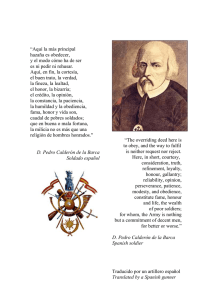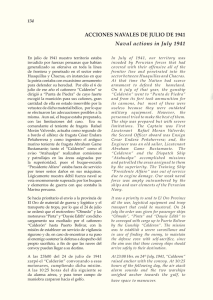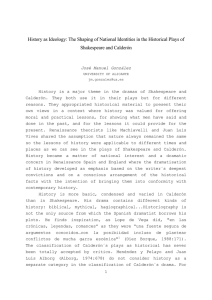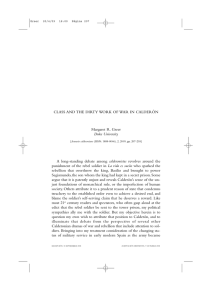Review/Reseña Contesting the Origins of Costa Rica`s Welfare State
Anuncio
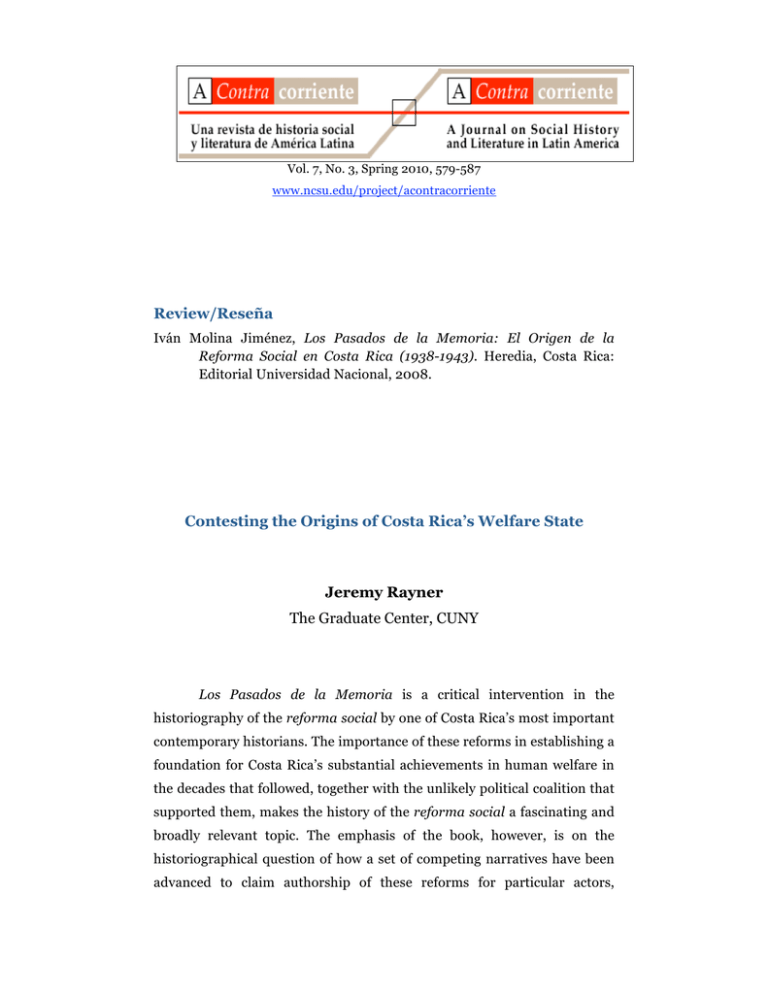
Vol. 7, No. 3, Spring 2010, 579-587 www.ncsu.edu/project/acontracorriente Review/Reseña Iván Molina Jiménez, Los Pasados de la Memoria: El Origen de la Reforma Social en Costa Rica (1938-1943). Heredia, Costa Rica: Editorial Universidad Nacional, 2008. Contesting the Origins of Costa Rica’s Welfare State Jeremy Rayner The Graduate Center, CUNY Los Pasados de la Memoria is a critical intervention in the historiography of the reforma social by one of Costa Rica’s most important contemporary historians. The importance of these reforms in establishing a foundation for Costa Rica’s substantial achievements in human welfare in the decades that followed, together with the unlikely political coalition that supported them, makes the history of the reforma social a fascinating and broadly relevant topic. The emphasis of the book, however, is on the historiographical question of how a set of competing narratives have been advanced to claim authorship of these reforms for particular actors, Contesting the Origins of Costa Rica’s Welfare State 580 producing, Molina argues, a historiographical tradition that greatly exaggerates the role of certain individual protagonists while misrepresenting their motives and under-emphasizing the broader context of electoral competition and economic crisis. The book therefore speaks both to the historical question of the origins of the reforms and to the historiographical (but also highly political) question of how historical knowledge about them has been produced. The reforma social consisted of three initiatives promulgated during the presidency of Rafael Ángel Calderón Guardia (1940-1944). The first of these initiatives was the foundation, in 1941, of the Caja Costarricense de Seguridad Social to provide healthcare coverage (and later, pensions as well). The other two measures, both passed in 1943, included a progressive labor code and the addition to the constitution of a chapter on Garantías Sociales, concerning social welfare and labor rights. How these reforms were achieved, by whom, and why, has been the subject of scholarly research, polemics, public memorialization and, as Molina documents, a set of more subtle yet influential interventions in the historical record. The principal actors, whose protagonism is in question, are, in addition to Calderón himself, the Archbishop Víctor Sanabria and the Communist leader Manuel Mora. At the heart of the issue is the nature and timing of the collaboration that ultimately occurred between these three and the disparate constituencies that they represented. By the 1944 election, the working relationship between them had taken the form of an electoral coalition, the Bloque de la Victoria, between Mora’s Vanguardia Popular and Calderón’s Partido Repúblicano Nacional. This alliance is undoubtedly an immensely significant fact of Costa Rican history. Beyond its role in the social reforms, it shaped the contours of the civil war of 1948 in which both the Communists and the Calderonistas were defeated by the followers of José Figueres Ferrer, founder of the Partido Liberación Nacional, which would dominate the postwar political landscape. What was the relationship between this alliance, formalized at the end of Calderón’s presidency, and the social reforms carried out in the preceding years? Did collaboration between these actors precede or follow the reforms? Was it a result or a Rayner 581 cause of them? How did the parties to the alliance relate to each other and to the reforma social? In Los Pasados de la Memoria, Molina engages critically with the historiographical tradition that has developed in response to these questions, while advancing his own interpretation of the processes that brought into being both the reforma social and the alliance between Calderón’s PRN, the Communists, and the Church. Molina’s own interpretation of this process (which was described in more detail in his previous book, Anticomunismo Reformista),1 is that the social reforms were initiated by Calderón as an attempt to co-opt the electoral force of the Communists, who, in the context of the long crisis of the 1930’s and 40’s, had been able to mobilize discontent into significant electoral gains (originally as the Bloque de Obreros y Campesinos, or BOC, which later became Vanguardia Popular). A growing division in his own party and subsequent challenges in the electoral arena, however, rapidly pushed Calderón towards an alliance with the Communists, who themselves had begun actively maneuvering for influence with the administration shortly after the plan to create the CCSS was announced. Archbishop Sanabria, in turn, was mainly interested in reversing the 19th century anti-clerical laws, and had formed an alliance with Calderón before the 1940 election in the hopes of achieving concessions in this area. Sanabria’s subsequent support of Calderón’s electorally-motivated reform initiatives and his tactical alliance with the BOC/VP followed this same logic. While Molina insists that Calderón’s initiative to found the CCSS preceded any relationship of cooperation with the BOC—and indeed emerged from his party’s competition with them—he is ultimately agnostic on the Communists’ influence on the organization of the CCSS, as well as in the authorship of the Labor Code and the Garantías Sociales. In the end, the process of approximation between the Calderonistas and the BOC that he presents is fitful, contradictory, and murky—which, in fact, fits with the thrust of his Iván Molina Jiménez, Anticomunismo Reformista (San José: Editorial Costa Rica, 2007). 1 Contesting the Origins of Costa Rica’s Welfare State 582 argument: this alliance was a marriage of convenience that occurred despite its contradictions. This account of the reform process, however, is not really laid-out until the last few chapters. The bulk of the book involves a systematic questioning of the historiographical tradition: its misuse of sources, its lack of attention to contrary evidence, and the politics driving the various claims within it. One of these claims is that Calderón’s and Sanabria’s actions emerged from their commitment to “Social Christianity.” Molina musters substantial evidence that, to the contrary, neither of these figures showed significant concern with addressing the “social question” at any point in his career before the propagation of the reforms (he also argues, somewhat less convincingly, that Calderón was not particularly religious). This lack of evidence for substantial commitment to social reform, as well as the extensive positive evidence he musters to demonstrate Calderón’s and Sanabria’s long-standing anti-communism, serves to reinforce Molina’s claim that the reforms originated as an electoral strategy, motivated by Calderón’s desire to consolidate his political career, Sanabria’s hope of overturning the anti-clerical laws, and their joint desire to defuse the Communist’s growing influence. The invocation of Social Catholicism by Calderón and Sanabria was, then, little more than an ideological justification for pragmatic political decisions, which researchers have tended to take at face value rather than investigate critically. While the influence of this narrative declined somewhat after the civil war as the Calderonistas attempted to reposition themselves politically, it was later renewed as the right sought to reconsolidate itself under the banner of Social Christianity, and received further impetus once Calderón’s son was elected to the presidency in the 1990’s. Emphasizing Calderón’s social commitments also seems to have served Mora politically. The representation of Calderón as a well-intentioned, if naïve, social reformer originally justified the Communists’ alliance with him, and later, by making an early working relationship between them credible, served to bolster Mora’s own claims to have been a principal protagonist in the reforms from the outset. Rayner 583 Much of the book is devoted to challenging claims that Mora had been the principal agent of the reform process. Carefully examining declarations by Mora and other Vanguardistas, Molina shows that the Communists’ narratives on the social reforms evolved in the twenty years after the 1948 Civil War, from assigning a leading role to Calderón, to claiming that Calderón had been obliged by Mora to pursue the reforms in exchange for the Communists’ support. The high point was Mora’s claim in an interview with a young historian that he had agreed to defend Calderón against a secret coup plot in exchange for pursuing this agenda, including the CCSS. Molina begins by noting the temporal inconsistencies in Mora’s account, which seemed to place the coup plot in 1942, after the foundation of the CCSS, which occurred in 1941. He then examines how this contradiction, as well as the inconsistencies in various other complementary testimonials that emerged over the years, were either ignored or smoothed over in subsequent historical accounts that accepted the basic validity of Mora’s story. Molina is in fact skeptical both of the likelihood of a coup plot and of the probability that Mora and Calderón had a working relationship at any time before the initiative of the CCSS. Through a close reading of the Communist’s publication, Trabajo, Molina suggests that the party was in fact caught by surprise by this initiative from their erstwhile reactionary opponent, and reacted at first by questioning its sincerity and feasibility. Furthermore, he emphasizes the significance of the generally-ignored electoral reforms of 1941, which, he argues, were clearly intended to counter the BOC’s successes at the ballot box, casting further doubt on the likelihood of a cooperative relationship between Calderón and the Communists in the early years of his presidency, and supporting the thesis that the CCSS was directed against the Communists as part of a process of inter-party competition. Molina argues that Mora’s questionable narrative entered the historical record without having been subject to critical examination in light of other available sources. And, just as with the narratives regarding the roles of Calderón and Sanabria, he aims to show that the less-thancritical acceptance of Mora’s account as historical truth was encouraged by Contesting the Origins of Costa Rica’s Welfare State 584 partisan interests. While scholars on the left played a role here, Molina shows that the partisans of Liberación Nacional were also increasingly willing to emphasize the protagonism of Mora and the PVP from the 1960’s on, as Mora and the PVP moved closer to the PLN and what Molina calls the “official culture.” Perhaps more importantly, Mora’s story served to diminish the claims to protagonism of Calderón and his successors, who represented the more significant threat to the PLN’s political power in the postwar period. The combined weight of left-leaning and Liberacionista intellectuals was enough to ensure that Mora’s narrative was established as largely authoritative, marginalizing Calderón as an agent of the reforms. Finally, Molina engages the historiography on the role of the “fourth man,” Oscar Barahona Streber, who has at times been credited as a principal agent of the reforms. Barahona Streber, who as a law student was apparently involved in the drafting of the reform legislation, progressively claimed a greater and greater role as the intellectual author of the reforms. Again, Molina investigates the politically-inflected process whereby Barahona Streber’s narrative was able to enter into the historical record, while bringing in an extensive array of primary sources to cast doubt on the significance of his role. Although Barahona Streber’s attempts to claim authorship of the reforms were largely unsuccessful, Molina’s chapters on Barahona Streber are among the most interesting in the book. Molina argues that while Barahona Streber entered into the historiography initially as part of a Calderonista rebuttal to Mora’s claims, a careful examination of contemporary sources strongly suggests that Barahona Streber was, at the time of the writing of the reform legislation, in fact very closely linked to the BOC. In considering Barahona Streber’s apparent affiliations and his role in the writing of the legislation, Molina is led to consider again the possibility of a substantial role for the Communists in the implementation of the reforms (although not the original proposal to found the CCSS). He ends by calling for further empirical research on this role. A stated purpose of this book is to convince researchers not to take the testimony of important political actors at face value, and to place more emphasis on other kinds of primary sources. While this is an important intervention into this particular historiographical tradition, I think that this Rayner 585 study has wider implications and points to a host of important questions. His previous book, Anticomunismo Reformista, Molina argues in the preface, served to question the emphasis given to individual historical figures and to call attention to aspects of the broader political context such as electoral competition and economic depression. Pasados de la Memoria effectively continues in this vein by questioning a few leading figures’ claims to extraordinary protagonism and re-situating them in the context of larger forces that they could not fully control. This is important in part because the personalistic emphasis of much of the historiographical tradition would seem to have ideological significance beyond the political stakes of partisan competition to claim credit for the reforms. A striking commonality between the historical narratives that Molina interrogates is the idea that great institutions are founded by the great deeds of great men. This is, of course, a theme common to most, if not all, processes of state formation, but the Costa Rican version is interesting because of the extent to which political legitimacy has been based on the claims of heroic figures such as Calderón and Figueres to be beneficent and visionary founders of the institutions of the welfare state. There are, however, interesting differences between the narratives of Mora and others from the VP, on the one hand, and the narratives of, say, Calderón and his followers, on the other. Mora’s narratives tend to situate himself in relation to the Party and the pueblo, a tendency that is even more evident in the narratives of the other Communists. They also tend to emphasize processes of ideological and political struggle beyond the electoral arena, and to represent these as essential parts of the reform process. These narratives point to ideological and political conflicts beyond the electoral realm that are potentially important to the narrative that Molina advances here. One important issue is the question of the class conflict over the reforms, which has been an important current in the historiography of this period. In arguing against the likelihood of the coup plot that Mora describes, Molina downplays the opposition of Costa Rica’s economic elites. Likewise, he tends to explain the challenges Calderón faced to his power in terms of intra-party competition and the aspirations of his rival, León Cortés, rather than class-based resistance to Calderón’s reform Contesting the Origins of Costa Rica’s Welfare State 586 program. But these were reforms that would seem to carry substantial costs for capital, costs that might be felt particularly acutely in the profit squeeze of a decades-long crisis. Moreover, laws to limit the working day and to establish minimum wages, paid vacations and the like have generally been contentious. There are also other potentially important processes such as the persecution of the well-endowed German community, which have often been invoked in explaining Calderón’s troubles. Is there perhaps more truth in Mora’s coup story than Molina allows? A related issue concerns the nature of the anticommunism represented by Calderón, Sanabria, and their followers. From Molina’s account, it is not clear to me to what extent the reforms were antiCommunist per se, and to what extent they were strategies to win elections in a context in which the Communists had succeeded in shifting the debate towards the need to address working conditions and welfare, between which there is a real, if subtle, difference. If Calderón and Sanabria were very committed anti-Communists, then the eventual alliance that emerged would seem very remarkable indeed. It seems more likely to me that their anti-Communism was provisional rather than absolute. On the other hand, the importance of anti-Communism as a political force in the Costa Rica of the 1940’s is amply evident in this and other accounts. These were after all times when the Communists represented a potential threat to the established order, not just as an electorally-competitive political party, but as trade union organizers and perhaps as potential revolutionaries. The argument that the reforma social began with anticommunist intent might be true, but it would seem that there were probably more dedicated anticommunists than Calderón and Sanabria, and that this contrast was probably an important part of the political dynamic of the 1940’s that led from progressive reforms to civil war. In sum, the role of class conflict is an old question in the scholarship on the reforma social, and Molina has made a substantial contribution to rethinking that question. But he also makes clear how much research still needs to be done, even on the question of when and how the cooperation between the BOC and the Calderonistas began and what form it took. The process of the reforma social bears Rayner 587 further examination through the kind of careful historical scholarship that Molina advocates, and practices, here. Los Pasados de la Memoria is the product of the kind of thorough scholarship that readers have come to expect from Iván Molina, who makes extensive use of under-utilized primary sources to take a fresh look at important questions in Costa Rican history. At the same time, it treats a particular topic in great detail, while assuming a substantial degree of prior knowledge regarding the important actors, chronology, content, context, and significance of the reforms. The very structure of the book, which begins with the historiographical debate and only gradually works towards a narrative of the processes addressed by those histories, presumes a highly informed reader. Finally, the focus on questions addressed directly to the historiography of the reforma social would limit its appeal to a more general readership. That said, I think that this book should probably be required reading for any scholar concerned with 20th century Costa Rican history and politics. For a more general readership with an interest in Molina’s explanation of the political origins of the Costa Rican welfare state, however, I would recommend Anticomunismo Reformista instead, which presents a more narrative account of the reforma social.

